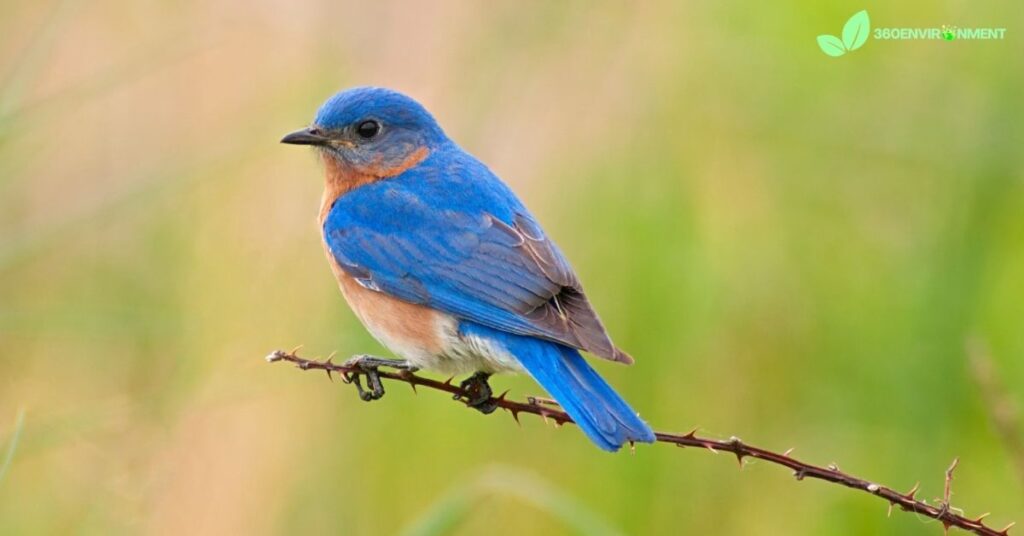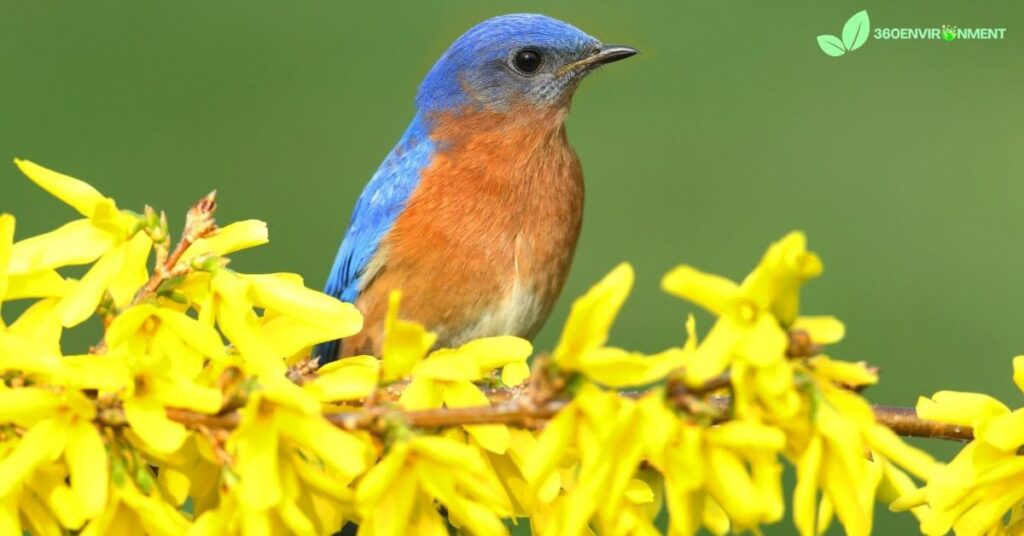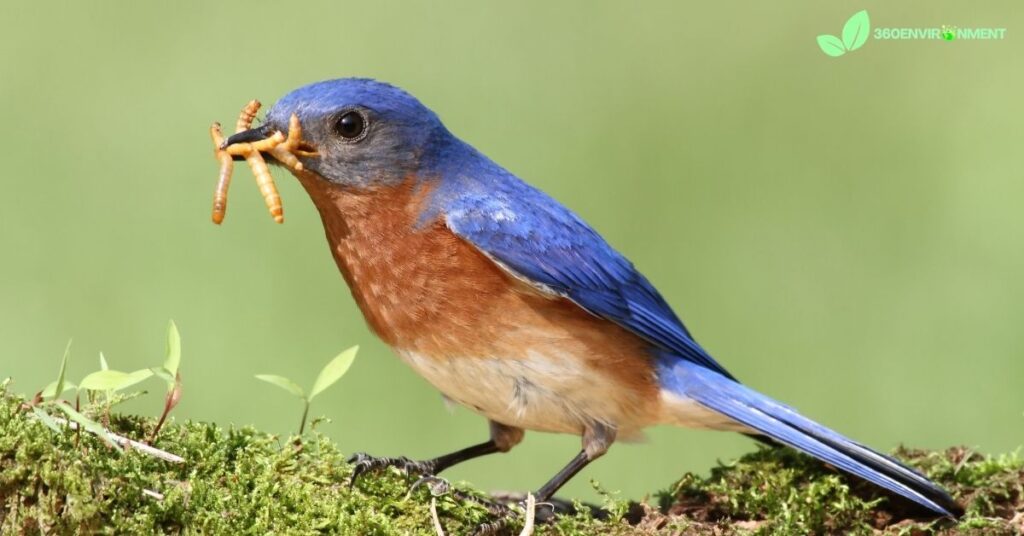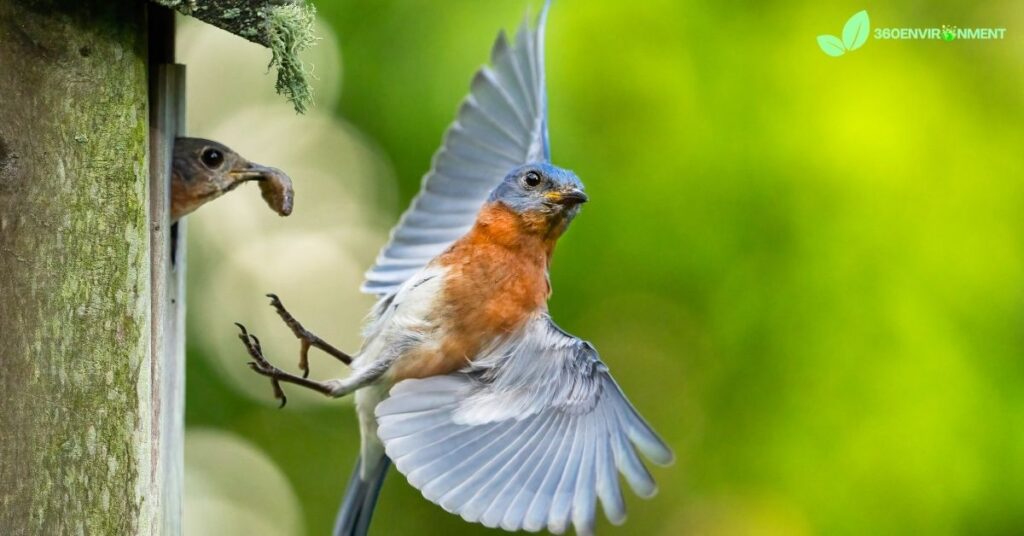Introduction
The female bluebird, often overshadowed by the brighter plumage of her male counterpart, plays an equally vital role in maintaining the balance of ecosystems. These small, thrush-like birds are more than just a beautiful symbol of natural beauty; they are integral parts of their environment, contributing to biodiversity, seed dispersal, and the control of insect populations. Female bluebirds, with their more subdued coloration and nurturing instincts, are essential for the reproduction and survival of their species.
This article explores the ecology and biology of the female bluebird, focusing on her role in the ecosystem, her behavior, her distinctive physical traits, and the environmental challenges she faces. We will examine how female bluebirds contribute to biodiversity, their nesting and feeding habits, and what conservation efforts are needed to protect them in a rapidly changing world.
1. The Three Species of Bluebird
Before diving into the specific attributes and behaviors of the female bluebird, it’s important to note that there are three species of bluebirds: the Eastern Bluebird (Sialia sialis), the Western Bluebird (Sialia mexicana), and the Mountain Bluebird (Sialia currucoides). Though they share many similarities, their ranges, habitats, and some physical traits differ.

1.1. Eastern Bluebird
The Eastern Bluebird is the most common and widespread species in North America, with habitats stretching from the eastern United States into parts of Canada and Mexico. They thrive in open woodlands, meadows, and farmlands where they can easily access insects and nesting sites.
1.2. Western Bluebird
The Western Bluebird occupies habitats ranging from the Pacific Coast to the Rocky Mountains. Unlike the Eastern Bluebird, they prefer more forested areas and are found in pine-oak woodlands, high desert regions, and even urban settings if enough green space is available.
1.3. Mountain Bluebird
The Mountain Bluebird is distinguished by its preference for higher elevations, such as in mountainous regions of the western United States and Canada. They are often found in alpine meadows, open grasslands, and sagebrush environments.
2. Physical Characteristics of the Female Bluebird
Female bluebirds are less vibrant than males, a common trait in bird species where subtlety aids in protecting the nest and evading predators. Despite these differences, female bluebirds are equally captivating in their unique way.

2.1. Coloration and Size
Female bluebirds are typically smaller than males, measuring around 6-7 inches in length with a wingspan of 9-12 inches. Their plumage is less vivid, with shades of gray, blue, and light brown. The Eastern Bluebird female has a more muted blue on her wings and tail, with a rusty orange breast and a grayish head. Western Bluebird females tend to have duller blue plumage, and Mountain Bluebird females are pale gray with faint blue tinges on the wings and tail.
This subtle coloration allows female bluebirds to blend into their surroundings, offering better camouflage while incubating eggs or caring for fledglings. The less conspicuous appearance is particularly advantageous during nesting season when the female spends long periods in the open.
2.2. Distinctive Features
While less colorful, the female bluebird has distinct features that help differentiate her from males and other bird species. Her slender, streamlined body is adapted for efficient flight, and her slightly curved beak is perfect for catching insects and other small prey. Females also have a noticeable white eye-ring, which can be seen in all three species.
3. Behavior and Ecology of the Female Bluebird
Understanding the behavior and ecological role of the female bluebird is essential for grasping her importance within her habitat. Female bluebirds are primarily responsible for nesting and caring for the young, though they also contribute to other key ecological functions.

3.1. Nesting and Reproductive Roles
The female bluebird takes the lead in nest building, although males may assist by finding suitable nesting sites. Bluebirds prefer natural cavities in trees, but they will also use birdhouses, especially in areas where natural habitats have been altered. The nest, typically built from grass, pine needles, and other plant material, is carefully constructed to protect the eggs from weather and predators.
- Egg Laying and Incubation: Once the nest is complete, the female lays a clutch of 3-7 pale blue or occasionally white eggs. She then incubates the eggs for about two weeks, maintaining the appropriate temperature to ensure successful hatching. During this time, the male bluebird often provides food to the female.
- Raising Fledglings: After the eggs hatch, the female plays the primary role in feeding the chicks, although the male also assists. The female ensures that the chicks receive a steady diet of insects and berries, helping them grow rapidly over the next 16-21 days until they are ready to leave the nest.
3.2. Diet and Feeding Behavior
Female bluebirds are insectivores and frugivores, feeding primarily on insects during the breeding season when they need extra protein to sustain themselves and their offspring. Their diet includes beetles, caterpillars, grasshoppers, and spiders, but they also consume berries, fruits, and seeds, particularly in the fall and winter.
- Insect Control: Bluebirds, including females, are crucial for controlling insect populations, especially during the spring and summer. By preying on insects, bluebirds help maintain the balance of ecosystems, preventing overpopulation of species that can damage crops or spread disease.
- Seed Dispersal: During the colder months, when insects are scarce, female bluebirds rely more on fruits and berries. As they consume these foods, they also contribute to seed dispersal, promoting plant regeneration and biodiversity in their habitats.
3.3. Habitat Preferences and Territoriality
Female bluebirds, like males, prefer open habitats such as fields, orchards, and woodland edges, where there is easy access to food and nesting sites. They are also territorial, especially during the breeding season, when they defend their nesting area from other bluebirds and potential threats.
- Nesting Territory: Female bluebirds are highly protective of their nesting sites, and they will aggressively defend their territory against intruders. This territorial behavior is crucial for ensuring the safety of their eggs and young, as overcrowding or competition could reduce their chances of survival.
- Winter Flocks: In winter, bluebirds, including females, often form small flocks and are less territorial. These flocks help bluebirds conserve energy and locate food sources more effectively during the colder months when resources are scarcer.
4. Environmental Importance of the Female Bluebird
The female bluebird’s role in the environment extends far beyond her immediate responsibilities for nesting and reproduction. As a keystone species in many ecosystems, bluebirds help maintain the health and balance of their habitats.

4.1. Pest Control and Ecosystem Balance
By feeding on a wide range of insects, female bluebirds help regulate insect populations in agricultural and natural ecosystems. This makes them valuable allies in pest control, reducing the need for chemical pesticides that can harm the environment and other wildlife.
- Agricultural Benefits: Farmers often encourage the presence of bluebirds on their land by installing nest boxes to help control pest populations naturally. Female bluebirds contribute significantly by consuming insects that could otherwise damage crops or spread to nearby habitats.
- Ecological Balance: In natural ecosystems, female bluebirds help maintain the balance of food webs by preying on insects that are critical to other species. This predatory role ensures that no single species dominates, allowing for greater biodiversity and healthier ecosystems.
4.2. Role in Plant Reproduction and Seed Dispersal
In addition to controlling insect populations, female bluebirds also play a key role in plant reproduction through seed dispersal. By consuming berries and fruits and excreting the seeds elsewhere, they help plants spread across their habitats, promoting genetic diversity and plant regeneration.
- Promoting Biodiversity: Seed dispersal by bluebirds supports plant diversity, which in turn benefits other species that rely on these plants for food, shelter, and nesting materials. The female bluebird’s contributions to seed dispersal are particularly important in fragmented or disturbed habitats, where natural regeneration is needed to restore ecosystem health.
4.3. Indicator Species for Environmental Health
Bluebirds, including females, are often considered indicator species because their presence or absence can reflect the health of an ecosystem. Healthy bluebird populations typically indicate that the environment provides sufficient food, shelter, and breeding sites, while declines in bluebird numbers may signal habitat degradation, pollution, or other environmental stresses.
- Habitat Loss and Fragmentation: Female bluebirds are particularly vulnerable to habitat loss due to urbanization, agriculture, and deforestation. As more natural habitats are destroyed, bluebirds lose their nesting sites and food sources, leading to population declines.
- Climate Change Impact: Climate change is affecting bluebird populations by altering the timing of migration, food availability, and nesting behavior. Warmer temperatures may lead to mismatches between the availability of insects and the timing of breeding, which can reduce reproductive success.
5. Conservation Challenges and Efforts for the Female Bluebird
Despite their environmental importance, bluebirds, including females, face numerous threats to their survival. These challenges highlight the need for targeted conservation efforts to protect bluebird populations and ensure their continued role in ecosystem health.

5.1. Threats to Female Bluebirds
Female bluebirds face several environmental and human-induced threats that jeopardize their ability to thrive in the wild and are particularly vulnerable to this loss, as they are responsible for selecting and maintaining nesting sites. Without suitable locations to lay eggs and raise young, bluebird populations can decline rapidly.
- Invasive Species Competition: Invasive species like European Starlings and House Sparrows often outcompete bluebirds for nesting sites. These aggressive birds can take over nest boxes or natural cavities, sometimes even attacking bluebirds and destroying their eggs. Female bluebirds, despite their protective instincts, are often unable to fend off these competitors, leading to lower reproductive success.
- Pesticide Use: The widespread use of pesticides in agriculture and urban environments also poses a significant threat to bluebirds. Pesticides can kill off the insects that bluebirds rely on for food, especially during the breeding season when females need extra nutrition to care for their young. Ingesting pesticide-contaminated prey can also lead to poisoning, further endangering bluebird populations.
- Climate Change: Climate change impacts female bluebirds in several ways, including altering the availability of food and suitable nesting sites. Warmer temperatures can lead to changes in the timing of insect emergence, potentially creating a mismatch between the availability of food and the bluebirds’ breeding season. This could reduce the survival rate of chicks, as females may struggle to find enough food to feed them.
5.2. Conservation Efforts for Female Bluebirds
To protect female bluebirds and their populations, conservationists have implemented several strategies aimed at providing safe habitats, increasing public awareness, and reducing threats from human activity.
- Nest Box Programs: One of the most successful conservation strategies for bluebirds is the widespread use of nest boxes. By installing bluebird-specific nest boxes in suitable habitats, conservationists and volunteers have helped provide safe nesting sites for female bluebirds. These boxes are designed to exclude invasive species like Starlings and House Sparrows, giving bluebirds a better chance of successfully raising their young.
- Public Engagement: Many organizations encourage individuals to participate in bluebird conservation by placing nest boxes in their yards or on their property. This grassroots effort has been instrumental in helping bluebird populations recover in areas where natural nesting sites are scarce.
- Habitat Restoration: Efforts to restore and protect bluebird habitats are critical for ensuring their long-term survival. These initiatives often involve replanting native vegetation, restoring wetlands, and protecting open woodlands where bluebirds thrive. Conservation groups work with landowners, farmers, and local governments to promote land-use practices that benefit bluebird populations.
- Reducing Pesticide Use: Promoting sustainable agriculture and reducing the use of harmful pesticides can have a positive impact on bluebird populations. Organic farming practices, integrated pest management (IPM), and the use of less harmful insect control methods help maintain healthy insect populations that female bluebirds rely on for food.
- Climate Change Mitigation: Addressing the broader issue of climate change is crucial for the future of bluebirds and countless other species. Conservationists advocate for policies that reduce greenhouse gas emissions, protect biodiversity, and create climate-resilient habitats. By mitigating the impacts of climate change, we can help ensure that female bluebirds continue to find the resources they need to survive.
5.3. Success Stories and Ongoing Challenges
Thanks to conservation efforts, bluebird populations have made a remarkable recovery in many parts of North America. Nest box programs, habitat restoration projects, and public engagement have all contributed to the resurgence of bluebirds, including females, in areas where they were once in decline.
- Eastern Bluebird Recovery: The Eastern Bluebird, in particular, has seen significant population increases thanks to dedicated conservation work. In the mid-20th century, Eastern Bluebird numbers had declined dramatically due to habitat loss and competition from invasive species. However, the widespread installation of nest boxes helped reverse this trend, and Eastern Bluebird populations are now stable or increasing in many areas.
- Ongoing Challenges: Despite these successes, female bluebirds still face significant challenges, especially in regions where habitat loss and climate change continue to threaten their survival. Conservation efforts must remain vigilant, particularly in protecting bluebird habitats from urban sprawl and industrial development. Continued public awareness and engagement are essential for maintaining the gains made in bluebird conservation.
6. The Role of Female Bluebirds in Cultural and Environmental Education
Beyond their ecological importance, bluebirds hold a special place in human culture and environmental education. Female bluebirds, like their male counterparts, are symbols of hope, happiness, and renewal in various cultures. Their presence in art, literature, and folklore has helped raise awareness of the need for conservation and the protection of wildlife.

6.1. Symbolism of Bluebirds
Bluebirds have long been associated with positive emotions and natural beauty. In many cultures, they are seen as harbingers of spring and symbols of happiness and peace. The female bluebird, though less colorful than the male, represents nurturing, motherhood, and the quiet strength needed to care for offspring and protect the next generation.
- Cultural Representations: Bluebirds appear in folklore, songs, and poetry across different cultures, often representing joy, prosperity, or a connection to nature. The image of the bluebird is frequently used to evoke feelings of contentment and the beauty of the natural world. By celebrating the symbolism of bluebirds, we can also raise awareness of the need to protect the environments they inhabit.
6.2. Bluebirds in Environmental Education
In environmental education programs, bluebirds serve as excellent ambassadors for wildlife conservation and habitat protection. Female bluebirds, with their vital role in raising young and maintaining the species, can help illustrate broader concepts about ecology, species interdependence, and the importance of biodiversity.
- Citizen Science and Bluebird Monitoring: Programs that engage the public in monitoring bluebird populations and maintaining nest boxes provide hands-on educational opportunities. Participants learn about the life cycle of bluebirds, their habitat needs, and the challenges they face. These programs also foster a sense of responsibility for protecting local wildlife.
- School Programs: Many schools incorporate bluebird conservation into their environmental curricula, teaching students about the importance of protecting natural habitats and wildlife. By focusing on the life and role of the female bluebird, educators can emphasize the importance of nurturing and caring for the environment, much like the bluebird cares for her young.
Conclusion: Protecting the Future of Female Bluebirds
The female bluebird is an essential part of the natural world, contributing to the health of ecosystems through her role in insect control, seed dispersal, and reproduction. As the quieter, less colorful counterpart to the male, the female bluebird often goes unnoticed, but her contributions to biodiversity and environmental stability are profound.
As we face increasing environmental challenges like habitat loss, climate change, and pollution, protecting female bluebirds and their habitats is more important than ever. Conservation efforts, public awareness campaigns, and habitat restoration projects are all critical for ensuring that bluebird populations, including females, continue to thrive.
By celebrating the role of the female bluebird and understanding her importance in the environment, we can inspire greater efforts to protect not only bluebirds but also the ecosystems they call home. With continued dedication to conservation, education, and sustainable land-use practices, we can ensure that future generations of bluebirds, along with the diverse species they interact with, will continue to grace our skies and landscapes for years to come.
Read More: Bird Talons: The Ultimate Tools of Survival in the Avian World

